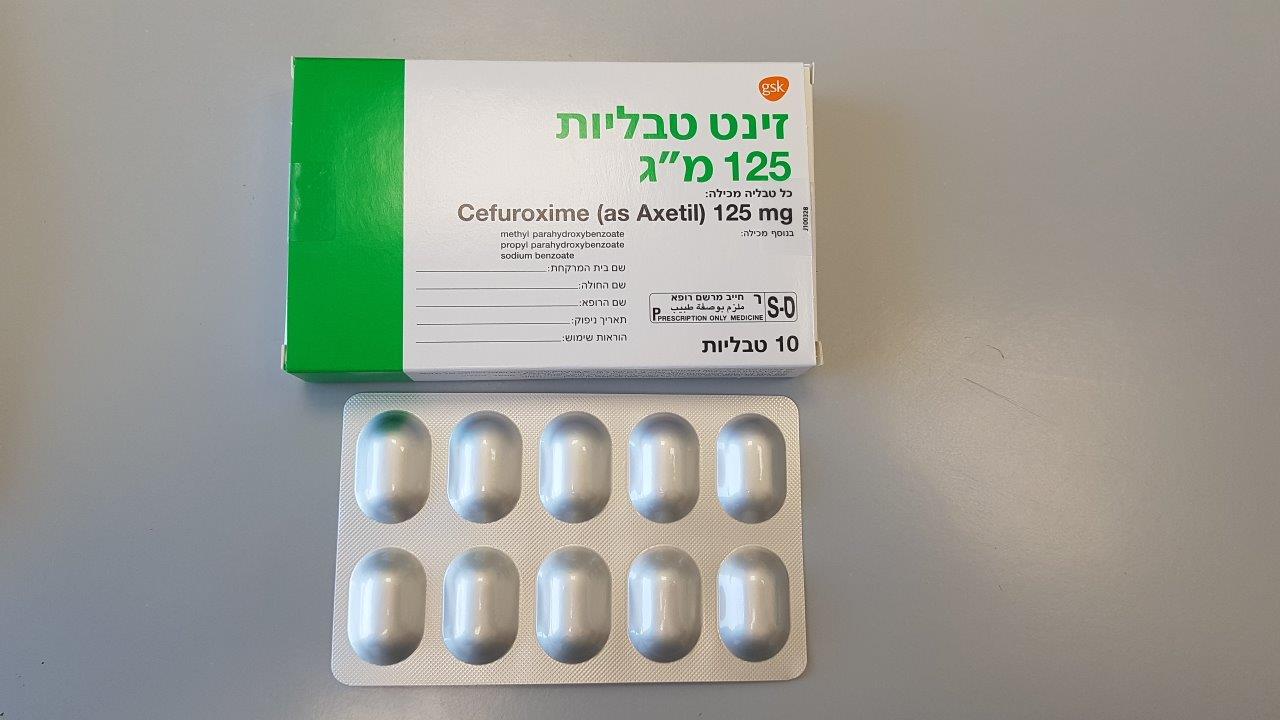Quest for the right Drug

זינט טבליות 125 מ"ג ZINNAT TABLETS 125 MG (CEFUROXIME AS AXETIL)
תרופה במרשם
תרופה בסל
נרקוטיקה
ציטוטוקסיקה
צורת מתן:
פומי : PER OS
צורת מינון:
טבליה : TABLETS
עלון לרופא
מינוניםPosology התוויות
Indications תופעות לוואי
Adverse reactions התוויות נגד
Contraindications אינטראקציות
Interactions מינון יתר
Overdose הריון/הנקה
Pregnancy & Lactation אוכלוסיות מיוחדות
Special populations תכונות פרמקולוגיות
Pharmacological properties מידע רוקחי
Pharmaceutical particulars אזהרת שימוש
Special Warning עלון לרופא
Physicians Leaflet
Special Warning : אזהרת שימוש
4.4 Special warnings and precautions for use Hypersensitivity reactions Special care is indicated in patients who have experienced an allergic reaction to penicillins or other beta-lactam antibiotics because there is a risk of cross-sensitivity. As with all beta- lactam antibacterial agents, serious and occasionally fatal hypersensitivity reactions have been reported. In case of severe hypersensitivity reactions, treatment with cefuroxime must be discontinued immediately and adequate emergency measures must be initiated. Before beginning treatment, it should be established whether the patient has a history of severe hypersensitivity reactions to cefuroxime, to other cephalosporins or to any other type of beta-lactam agent. Caution should be used if cefuroxime is given to patients with a history of non-severe hypersensitivity to other beta-lactam agents. Jarisch-Herxheimer reaction The Jarisch-Herxheimer reaction has been seen following cefuroxime axetil treatment of Lyme disease. It results directly from the bactericidal activity of cefuroxime axetil on the causative bacteria of Lyme disease, the spirochaete Borrelia burgdorferi. Patients should be reassured that this is a common and usually self-limiting consequence of antibiotic treatment of Lyme disease (see section 4.8). Overgrowth of non-susceptible microorganisms As with other antibiotics, use of cefuroxime axetil may result in the overgrowth of Candida. Prolonged use may also result in the overgrowth of other non-susceptible microorganisms (e.g. enterococci and Clostridium difficile), which may require interruption of treatment (see section 4.8). Antibacterial agent–associated pseudomembranous colitis have been reported with nearly all antibacterial agents, including cefuroxime and may range in severity from mild to life threatening. This diagnosis should be considered in patients with diarrhoea during or subsequent to the administration of cefuroxime (see section 4.8). Discontinuation of therapy with cefuroxime and the administration of specific treatment for Clostridium difficile should be considered. Medicinal products that inhibit peristalsis should not be given (see section 4.8). Interference with diagnostic tests The development of a positive Coomb’s Test associated with the use of cefuroxime may interfere with cross matching of blood (see section 4.8). As a false negative result may occur in the ferricyanide test, it is recommended that either the glucose oxidase or hexokinase methods are used to determine blood/plasma glucose levels in patients receiving cefuroxime axetil. Important information about excipients This medicine contains: 0.00152 mg sodium benzoate in each 125 mg tablet 0.00203 mg sodium benzoate in each 250 mg tablet 0.00506 mg sodium benzoate in each 500 mg tablet Zinnat tablets contain parabens which may cause allergic reactions (possibly delayed). Zinnat tablets contains less than 1 mmol (23 mg) of sodium, that is to say essentially ‘sodium free’.
Effects on Driving
4.7 Effects on ability to drive and use machines No studies on the effects on the ability to drive and use machines have been performed. However, as this medicine may cause dizziness, patients should be warned to be cautious when driving or operating machinery.

שימוש לפי פנקס קופ''ח כללית 1994
Upper & lower respiratory tract infections (sinusitis, otitis, chronic bronchitis, pneumonia) genitourinary infections, pyelonephritis caused by: staphylococcus aureus & epidermidis (excluding methicillin resistant strains), streptococci (excluding enterococci), H. influenzae (including beta lactamase resistant strains) Branhamella catarrhalis, E. coli, klebsiella species, proteus mirabilis, proteus rettgeri, providencia, N. gonorrhea (including penicillinase producing strains)
תאריך הכללה מקורי בסל
01/01/1995
הגבלות
תרופה שאושרה לשימוש כללי בקופ'ח
מידע נוסף
